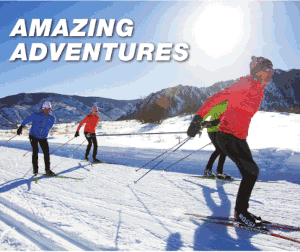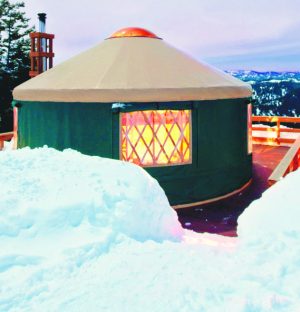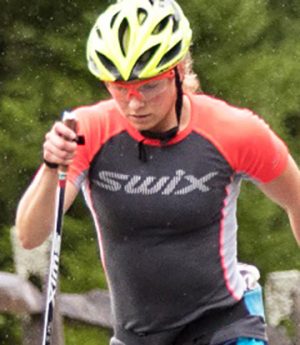May 22, 2016 (Barrow, Alaska) – Earlier this April in Barrow, Alaska, one of the most Northern inhabited towns in the world, two Olympic Nordic skiers sat in a school gym watching the kids play basketball as winds of thirty miles an hour raged across the Arctic ocean just outside the door. They were discussing an idea they both shared: that in a region beset with alcoholism, poverty, suicide and loss of cultural awareness, getting kids outside and skiing might a way to keep kids healthy and happy and help reengage them with a lost cultural heritage.
![Lars Flora and Becky Scott with Brooks Fry, the Health Teacher in Anaktuvuk Pass. Brooks and his wife have created a check out system for the skis where the students turn in cells phones for skis in the evening [P] Nathaniel Wilder and Skiku](http://skitrax.com/wp-content/uploads/2016/05/Brooks-Fry-copy.jpg)
Lars Flora and Becky Scott with Brooks Fry, the Health Teacher in Anaktuvuk Pass. Brooks and his wife have created a check out system for the skis where the students turn in cells phones for skis in the evening © Nathaniel Wilder and Skiku
This winter, Alaskan Olympian Lars Flora invited Canadian Olympic gold medalist, Beckie Scott, to come along to several villages in Northern Alaska to compare what his organizations, Skiku and NANANordic, are doing to what Scott is doing as ambassador for Ski Fit North Alberta in Canada. “The similarities are remarkable,” said Scott, who has been working for Ski Fit North for the last six years, “I’m always amazed at how just getting kids outside, active and involved seems to be a universally enjoyable experience for everyone.”
![Beckie participates in her country's favorite pastime in a slightly modified version on skis. Skiku incorporates basketball on skis and other games into daily lesson plans to teach good ski skills [P] Nathaniel Wilder and Skiku](http://skitrax.com/wp-content/uploads/2016/05/Beckie-basketball-copy.jpg)
Beckie participates in her country's favorite pastime in a slightly modified version on skis. Skiku incorporates basketball on skis and other games into daily lesson plans to teach good ski skills © Nathaniel Wilder and Skiku
The Skiku/NANANordic organization’s growth has been remarkable by any measure. Five years ago, about twenty volunteer ski coaches from around Alaska volunteered a week of their time to visit four Arctic villages in Northwest Alaska and began by teaching the kids how bindings worked. That program, called NANANordic after NANA, the regional corporation that serves the 98,000 square kilometer area from the Northern Coast of the Seward Peninsula to the upper Kobuk River, has grown for the past five years from four villages to 42, with 130 volunteer coaches reaching nearly 4,500 kids in some of the most isolated communities in the state. In 2012, a sister organization called Skiku was created in order to serve communities outside of the region owned by the NANA Native Corporation.
![High School basketball players mastering standing 360's [P] Skiku](http://skitrax.com/wp-content/uploads/2016/05/High-School-basketball-copy.jpg)
High School basketball players mastering standing 360's © Skiku
Flora said he reached out to Scott on a whim, not expecting that she would accept, but Scott was thrilled at the chance to see what was going on in Alaska. At Anaktuvuk Pass Scott was impressed by the way a local gym teacher loaned out the schools skis after dinner time; in the regional hub of Barrow, Scott went out with kids in 30-mile-per-hour winds as the community prepared for the season’s first bowhead whales to come through. Though her scheduled trip to Nuiqsut was canceled because of an unusually windy spring on the North Slope of Alaska, Scott got to experience a taste of Alaska.
Still, she said, the most valuable lessons were more about how she can improve Ski Fit North for the benefit of the kids. “I think the most valuable ‘take-home’ learning from my experience with Skiku, was the involvement of the numerous contract and volunteer based coaches they employ,” said Scott, “The amount of kids and schools that Skiku/NANANordic is able to reach and engage is really reliant on the collective efforts of many people, and it seems to be a very effective framework for program delivery.”
![Ski gloves made for the Arctic [P] Skiku](http://skitrax.com/wp-content/uploads/2016/05/Ski-gloves-copy.jpg)
Ski gloves made for the Arctic © Skiku
Flora said that the interchange of ideas he had with Scott was rewarding as well as humbling. In rural Alaska where basketball is king, the local high school basketball star Kamaka Hepa gets a louder reception every time he walks in the gym. “Everybody was on their feet when Hepa walks in,” said Flora, “When they hear Beckie won an Olympic gold they are excited of course, but it’s not the same. It puts what we are doing in perspective.”
Turning up the competition
Flora had a lot to discuss. Earlier in the month he organized three inter-village races in the NANA region with participation from at least 160 kids in the villages of Noorvik, Kotzebue and Ambler.
![(l-r) Becky Scott, Louisa Stein, Lars Flora. Louisa Stein who grew up as a skier in Anaktuvuk Pass and raced for Lathrop High School is currently working at the school in AKP. She competed at multiple Junior Nationals in the 1970's [P] Nathaniel Wilder and Skiku](http://skitrax.com/wp-content/uploads/2016/05/Louisa-Stein-copy.jpg)
(l-r) Becky Scott, Louisa Stein, Lars Flora. Louisa Stein who grew up as a skier in Anaktuvuk Pass and raced for Lathrop High School is currently working at the school in AKP. She competed at multiple Junior Nationals in the 1970's © Nathaniel Wilder and Skiku
“We wanted to have one big regional race for all of NANA,” said Flora, “But we realized pretty soon that we didn’t have the budget and they [the school district] didn’t have the budget to fly everybody in somewhere, so two or three of the of the principals and I came up with this plan to split the region up in three so that the different villages could snow-machine over to the race.” Upper Kobuk racers from Kobuk and Shungnak were invited to a race in Ambler; Kiana and Selawik were invited to the Noorvik race; and Buckland was invited to the race in the regional hub of Kotzebue.
![Elementary students head to the ice for 45 minutes of ski during school in Kotzebue [P] Skiku](http://skitrax.com/wp-content/uploads/2016/05/Elementary-students-ski-in-Kotzebue.-copy.jpg)
Elementary students head to the ice for 45 minutes of ski during school in Kotzebue © Skiku
At Noorvik, population 800, students were in for a special surprise: five of the top skiers in the US arrived on a charter flight from Kotzebue on Saturday morning, including Olympian Brian Gregg and three other National Champions. After hosting the community race for the kids, the elite skiers, along with Flora lined up along the start line for a show race with a special criterium-style event of twenty minutes followed by a final lap. “It was fun to come up the hill see the kids chanting “Skiers! Skiers!’” said Flora, a former US national champion, “These kids don’t know what skiing is about. In the US, almost everybody spectating at a race is a skier so it was really cool to see how they got into it.”
Robin Kornfield, an Iñupiaq who was one of the founders of NANANordic, said that the racing is about sustainability: “Were looking for a way to create a sustainable ski culture. Part of that ends up being racing. I’ve done quite a bit of discussion with other villages and we saw that kids love races. It gets them excited.”
![Noorvik race [P] Lars Flora](http://skitrax.com/wp-content/uploads/2016/05/Noorvik-race-photo_D1A1928-copy.jpg)
Noorvik race © Lars Flora
Flora said that he hopes that be next year he can team with the Northwest Arctic Borough School District and host a regional race for the 11 NANA villages which would serve as a qualification for the Western Interior Skiing Association Championships, or WISA. Keith Conger, the president of WISA who also traveled along with NANANordic this year as a volunteer coach, said that he sees potential in the region. “I think they’re to the point where there are kids out there who could have gone to WISA and competed. Maybe not be fighting for podium, but would have had great experiences. We saw some really strong skiers there.” he said.
Keeping it in context
Conger, Flora and Skiku Biathlon Director, Zach Hall, pointed to a tradition of endurance athletics competition in the NANA region: Elliot Sampson, an Iñupiaq from Noorvik came from nowhere to win the 1981 State High School Cross Country Championship against Marcus Dunbar, who would become a national champion in the mile. Sampson trained on snow shoes through the winter and credited his diet heavy in seal oil with his surprise win. However, his tale is cautionary: Sampson was recruited on a running scholarship by the University of Oregon, but was unable to deal with life in the city and met an cold death in mid-winter back in 2004 in Fairbanks, where he was found after escaping from an assisted living facility.
![Noorvik race [P] Lars Flora](http://skitrax.com/wp-content/uploads/2016/05/Noorvik-race-photo_D1A1897-copy.jpg)
Noorvik race © Lars Flora
Scott said that awareness of the larger context of history and culture helps coaches in both Alaska and Canada. She cited the Truth and Reconciliation Report that was released in Canada last year as having helped raise awareness of some of the issues facing indigenous people, as well as historical causes. “Having awareness and understanding of the adversity the kids we work with are up against makes us more compassionate, understanding leaders,” she said in an email, “This in turn, strengthens our commitment to ensuring that the experience our kids have is positive, supported and fun. There is so much to be gained from engaging in sport and outdoor activity (as provided by both programs), and we are really committed to ensuring our kids get as much out of it as possible.”
![Sara Studebaker, 2010 Olympian leads out the racers on the first official race of the year in Ambler, Alaska [P] Skiku](http://skitrax.com/wp-content/uploads/2016/05/Sara-Studebaker-copy.jpg)
Sara Studebaker, 2010 Olympian leads out the racers on the first official race of the year in Ambler, Alaska © Skiku
While NANANordic was taking place, there were at least two student suicides in the villages that coaches were coaching in. Flora said that it was the first time he had been so close to a suicide. “I told the school ‘We are available, we can continue, but it’s down to what the family wants and what the school wants’. They told us they wanted us to stay and coach, and I think it ended up being a good thing for everybody.”
Olympian Scott added that it’s a balance between ambitions and humility. “I think it’s safe to say that neither of us are trying to change the world with cross-country skiing, but when I reflect on these programs in the grand scheme of a solution-based approach to the big issues, I really believe organizations like Skiku and Ski Fit North have a place and a role,” she added, “Sport for development can be a very effective means of engaging, educating and empowering our most vulnerable and marginalized children and youth, and there is a substantial body of research-based evidence behind that now.”
![Coaches Ryan Terry, Nancy Pfeiffer, and Fischer Gangemi helping to serve the local favorite Sheefish at the Kobuk 440 mushing dinner [P] Skiku](http://skitrax.com/wp-content/uploads/2016/05/Coaches-Terry-Pfeiffer-Gangemi-copy.jpg)
Coaches Ryan Terry, Nancy Pfeiffer, and Fischer Gangemi helping to serve the local favorite Sheefish at the Kobuk 440 mushing dinner © Skiku
“Racing is at the bottom of the priority list right now,” added Flora, who said that most of his time is focused on jumping, games, and point-to-point skis, “We have a lot of people say, ‘Oh you are helping the suicide rates, or you are helping this or that by getting the kids outside’ Maybe, but that’s not what we are thinking about. At the end of the day all the coaches are just doing their best to teach kids the fundamentals of how to ski.”
For more information on NANANordic click here.
![Lars Flora and Becky Scott with Brooks Fry, the Health Teacher in Anaktuvuk Pass. Brooks and his wife have created a check out system for the skis where the students turn in cells phones for skis in the evening [P] Nathaniel Wilder and Skiku](http://skitrax.com/wp-content/uploads/2016/05/Brooks-Fry-copy.jpg)
![Beckie participates in her country's favorite pastime in a slightly modified version on skis. Skiku incorporates basketball on skis and other games into daily lesson plans to teach good ski skills [P] Nathaniel Wilder and Skiku](http://skitrax.com/wp-content/uploads/2016/05/Beckie-basketball-copy.jpg)
![(l-r) Becky Scott, Louisa Stein, Lars Flora. Louisa Stein who grew up as a skier in Anaktuvuk Pass and raced for Lathrop High School is currently working at the school in AKP. She competed at multiple Junior Nationals in the 1970's [P] Nathaniel Wilder and Skiku](http://skitrax.com/wp-content/uploads/2016/05/Louisa-Stein-copy.jpg)
![Sara Studebaker, 2010 Olympian leads out the racers on the first official race of the year in Ambler, Alaska [P] Skiku](http://skitrax.com/wp-content/uploads/2016/05/Sara-Studebaker-copy.jpg)
![Coaches Ryan Terry, Nancy Pfeiffer, and Fischer Gangemi helping to serve the local favorite Sheefish at the Kobuk 440 mushing dinner [P] Skiku](http://skitrax.com/wp-content/uploads/2016/05/Coaches-Terry-Pfeiffer-Gangemi-copy.jpg)






![National camp action [P]...](https://skitrax.com/wp-content/uploads/2019/08/Duluth-4-2019-08-08-at-10.46.51-AM-300x246.png)
![Matt Liebsch on the CXC Elite Team [P] CXC...](https://skitrax.com/wp-content/uploads/2019/08/Matt-Liebsch-CXC.2-525x700.4-300x267.jpg)
![Dan LaBlanc [P]...](https://skitrax.com/wp-content/uploads/2019/08/Dan-LaBlanc-img_1855.3.jpg)

![High School basketball players mastering standing 360's [P] Skiku](http://skitrax.com/wp-content/uploads/2016/05/High-School-basketball-copy.jpg)
![Ski gloves made for the Arctic [P] Skiku](http://skitrax.com/wp-content/uploads/2016/05/Ski-gloves-copy.jpg)
![Elementary students head to the ice for 45 minutes of ski during school in Kotzebue [P] Skiku](http://skitrax.com/wp-content/uploads/2016/05/Elementary-students-ski-in-Kotzebue.-copy.jpg)
![Noorvik race [P] Lars Flora](http://skitrax.com/wp-content/uploads/2016/05/Noorvik-race-photo_D1A1928-copy.jpg)
![Noorvik race [P] Lars Flora](http://skitrax.com/wp-content/uploads/2016/05/Noorvik-race-photo_D1A1897-copy.jpg)